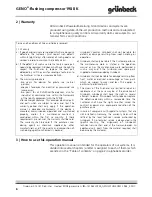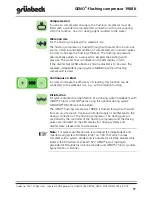
GENO
®
-flushing compressor 1988 K
Order no. 015 151 963-inter Created: KONS-gmei-mrie G:\BA-151963-INTER_GENO-SPUELKOMP-1988_K.DOC
13
Regardless of whether there is immediate discolouration of the water or
not, corrosion causes deposits to build up. These can be due to
precipitation in the hot water area or from the flushing in of solid
particles from the supply network (e.g., rust particles). If there are
deposits, there is a risk that these will be mobilised when a large
amount of water is withdrawn and, consequently, the water is
discoloured or becomes clouded. Moreover, deposits facilitate the
multiplication of micro-organisms which can, in turn, result in microbial
pollution. In order to prevent this, the installation must be cleaned if it
contains deposits.
In drinking water installation which are planned, built, commissioned,
operated and maintained in accordance with the generally recognised
codes of practice, the microbiological sound quality of the drinking
water is ensured at the withdrawal point. In particular the following
must be ensured:
Operation as intended (including regular withdrawal of water at all
withdrawal points)
Temperature of the cold drinking water not in excess of 25°C
Temperature of the hot drinking water in the entire circulation system
not below 55°C
Regular maintenance
If the microbiological parameters of the limit values of the drinking
water ordinance are exceeded or if the technical action value of the
drinking water ordinance is reached or exceeded or the requirements of
the UBA (Federal Environmental Agency) recommendations are not
complied with, microbial contamination must be eliminated in the
interests of health protection. In such cases, system disinfection may be
additionally necessary after cleaning.
Note:
Cleaning measures and system disinfection are only effective in
the long term if the causes of pollution, in particular in connection with
microbial contamination, have been remedied.














































